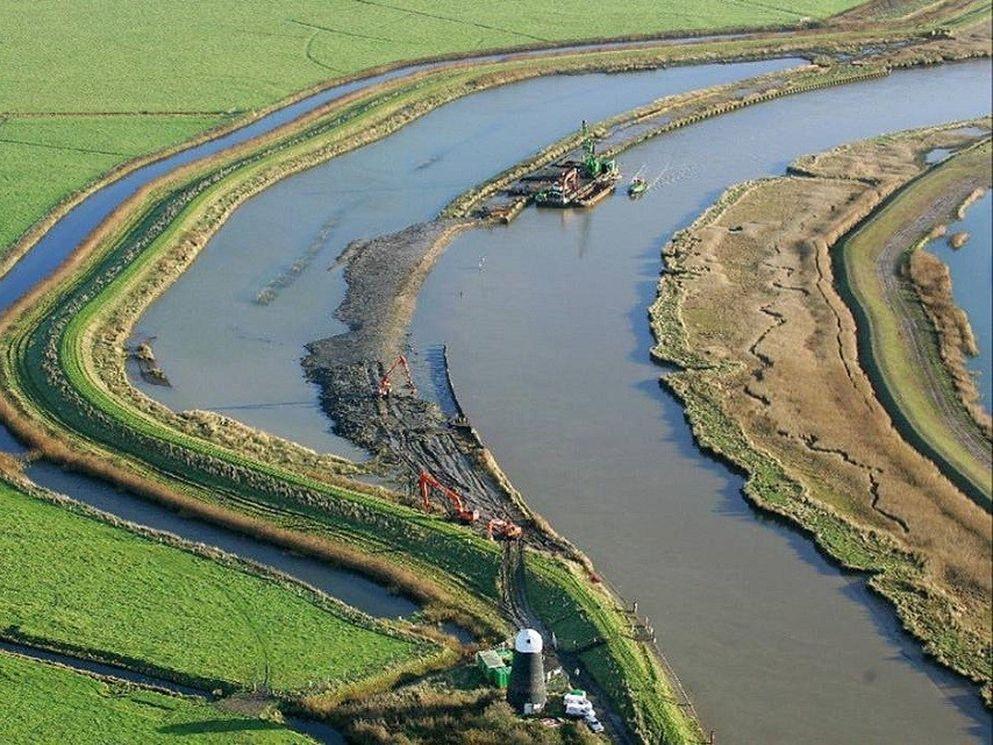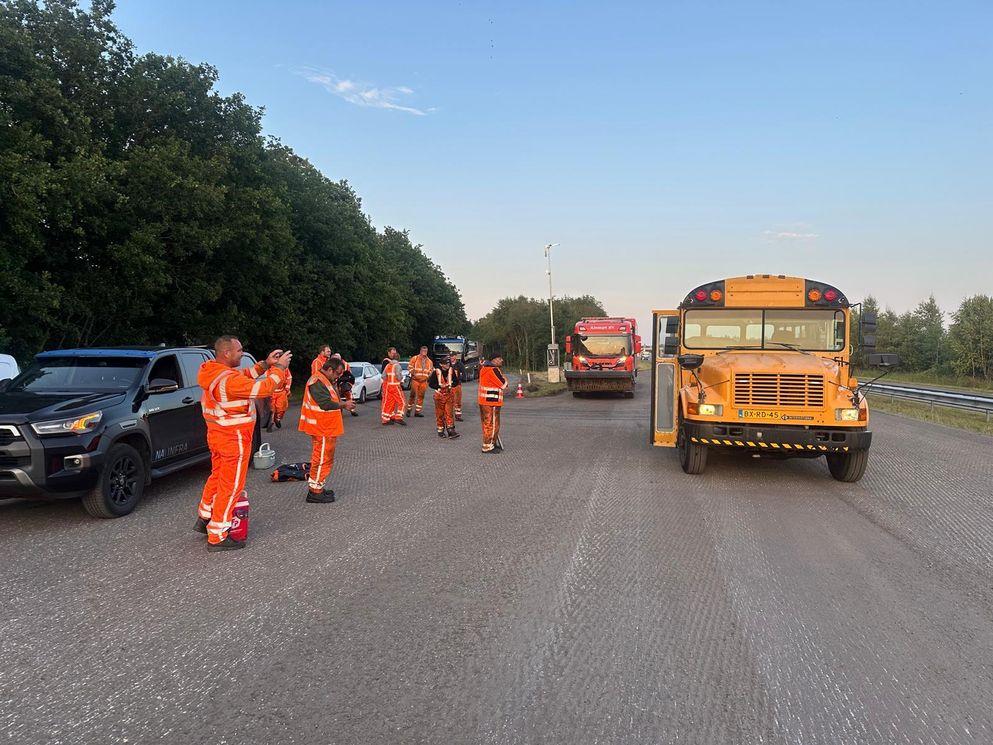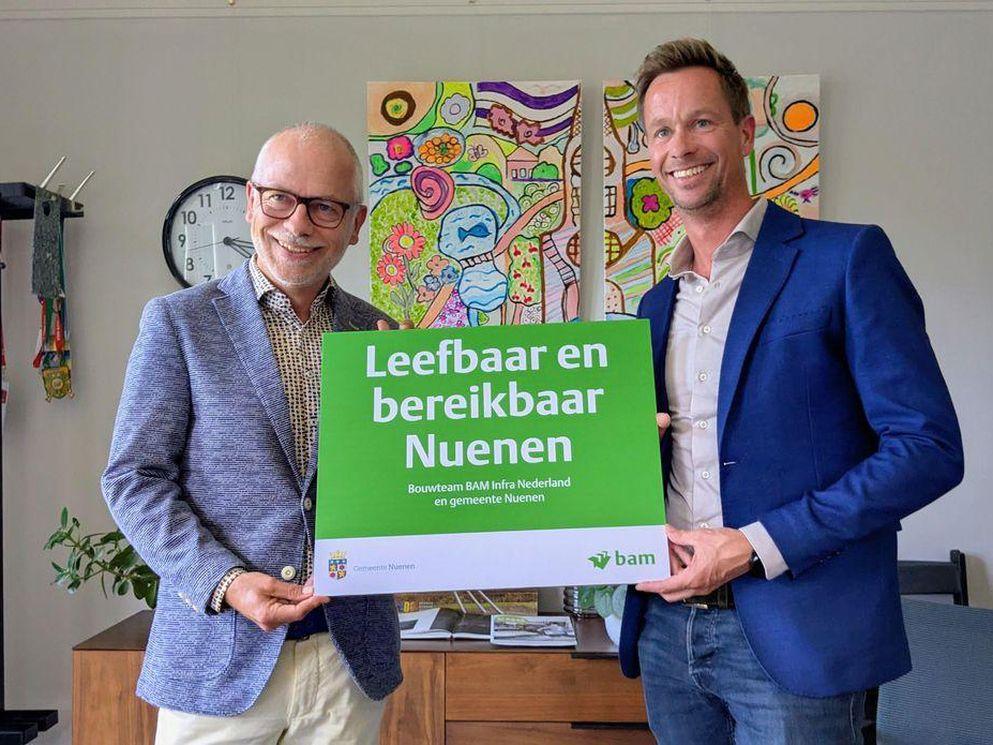Broadland flood alleviation project reaches 20 year landmark

Unique scheme to improve and maintain 240km of flood defences in the Norfolk Broads, one of Europe’s most important wetland areas
(Press release Environment Agency:) 1 September 2021 - A host of environmental benefits and flood defences for towns and villages around the Norfolk Broads are the result of a 20 year project reaching its conclusion.
Almost 2,000 homes and business and vital transport links are now better protected from 3 local rivers thanks to a multi million pound scheme from the Environment Agency.
There are also improved facilities for anglers, boaters, walkers and the many others enjoying the Broads for business or pleasure.
The completion of piling works at Burgh Castle on the River Waveney marks the final phase of the £140 million Broadland Flood Alleviation Project.
This project has improved flood defences, maintenance and emergency response services in the tidal areas of the River Yare, River Bure and River Waveney.
The project’s achievements include:
- Improved flood protection – 1700 properties and 5 previously undefended communities are now better protected from flooding. Over 240 kilometres of flood banks have been upgraded and 36 kilometres of banks realigned inland. Major transport links such as the A47 and Norwich/Great Yarmouth/Lowestoft railway lines are also better protected.
- Agriculture and land management – around 30,000 hectares of land are now at less risk of being breached by flood waters. This includes, 24,000 hectares of prime agricultural land and 28 Sites of Special Scientific Interest. Over 3 kilometres of overhead electric cables were moved underground.
- Angling, navigation and recreation – over 5 kilometres of public moorings and 5 slipways were upgraded, new angling platforms provided and 100 kilometres of public footpaths improved.
- Greener flood defences – by removing previously constructed hard edges, 28 kilometres of soft reeded fringes were created. These ‘green defences’ have new flood banks further back than before to allow the restoration of a traditional Broadland reed fringe.
- Carbon saving – reclaimed materials were utilised with some 7.5 kilometres of steel sheet and timber piles reused. Materials have also been processed and stockpiled for reuse at later dates.
- Benefits to biodiversity – there was a 200 per cent increase in the number of nationally endangered water voles during the course of the project. The thousands of biological records created by the project were passed to County Records Centres to contribute to the natural knowledge of the area.
Paul Mitchelmore, Environment Agency Project Manager, said: ‘This project has given us a unique opportunity to extend the life of these flood defences, and help to preserve the special qualities of the Broads. We now have a more sustainable flood defence system which will reduce the burden on future generations for its upkeep. More than 1700 properties and 5 previously undefended communities are now better protected from flooding and 30,000 hectares of land is now at less risk of being breached by flood waters. We have also been able to make improvements to public footpaths and several public boat moorings for the enjoyment of visitors. Throughout the project we have actively engaged in developing close working partnerships with stakeholders to incorporate their views and opinions into our plans. Working closely with Jacobs and BAM Nuttall as Broadland Environmental Services Ltd (BESL) enabled us to provide a lasting solution to an area of unique value to the environment.’
Donald Morrison, Jacobs People & Places Solutions Senior Vice President for Europe and Digital Strategies, said: ‘The Broadland Flood Alleviation Project will leave a significant legacy – safeguarding land and communities from flood, protecting local economic activity and providing an enhanced natural environment. The project’s success demonstrates that large scale improvement schemes with a strategic approach to improving existing flood defences can be accomplished within a nationally and internationally important wetland area. The close collaboration within the core delivery team and stakeholder and landowner involvement in the detailed phases of public consultation has been central to the success of this project.’
David McGowan, BAM Nuttall Business Excellence Officer, said: ‘Leading the development of innovative, sustainable solutions for rural flood protection schemes, this team maximised the use of material surrounding the work and minimised traffic through local communities. Repeating results along the 150 miles of defences, new habitats have been created for a variety of species to thrive. And over two decades, the project has provided employment and opportunities to develop skills for more than 1,000 local people, leaving a lasting positive legacy for people living and working in Norfolk.’
Future funding
As the effects of climate change increase, the Broads will continue to be eligible for potential funding through the National capital programme 2021 to 2027. This programme will see the government invest a record £5.2 billion in flood and coastal defences – double the previous investment – to better protect 336,000 properties.
The Environment Agency’s National Flood and Coastal Erosion Risk Management Strategy for England will help prepare for more extreme weather and build a better prepared and more resilient nation.
Further information
The Broads (Broadland) is a wetland area of international importance in eastern Norfolk and north Suffolk. The Broadland grazing marshes, wetlands and fens all lie below current high tides. The riverside settlements face a future of higher sea levels. Economic activity in the Broads, whether it be through agriculture, local commerce, recreational boating, fishing or rambling is heavily dependent upon reliable flood defences.
Broadland is a 22,000 hectare area of broads in Norfolk and Suffolk, most of which is below sea level. It is economically valuable largely due to farming and recreation – in particular, water based activities such as boating, sailing and angling. The area also has important roads and railways, including those that link Norwich with Great Yarmouth
There was widespread flooding in 1953. Since the start of the project, tidal flood events have happened in November 2006, November 2007, December 2013 and October 2014. 1953 levels have been exceeded on at least 2 occasions. During these events there has been some overtopping but fewer breaches have occurred. A small number of riverside businesses and houses have flooded but flooding is usually confined to agricultural land.
Full list of key achievements
Improved flood risk management
- Over 240 kilometres of flood banks upgraded, with over 36 kilometres of banks realigned inland
- 1700 properties and 5 previously undefended communities better protected from flooding
- Major transport links have also benefited including the A47 and Norwich-Great Yarmouth/Lowestoft railway lines.
Agriculture and land management
- 30,000 hectares of land protected from being breached by flood waters
- Including 24,000 hectares of prime agricultural land and 28 sites which are SSSI designated (Sites of Special Scientific Interest)
- Over 3 kilometres of overhead electric cables moved underground – improving the landscape and making the area safer for farmers and anglers.
Water
- 28km of hard, piled edges removed and replaced with soft reeded fringes. These ‘green defences’ are created by using a technique called setback – building a new flood bank further back and removing old piling next to the water to allow the restoration of a traditional Broadland reed fringe;
- This provides major landscape benefits as well as contributing to Water Framework Directive objectives. Angling, navigation and recreation
- 5.2 kilometres of public moorings and 5 slipways upgraded;
- New angling platforms provided;
- Setback areas provide 500,000 cubic metres of dredging disposal sites which create new areas for flood alleviation, habitat and recreation;
- 100 kilometres of public footpath improved, with over 5 kilometres surfaced for easy access. Delivered in partnerships with local authorities.
Environmental performance
- Use of reclaimed materials - some 7.5 kilometres of steel sheet and timber piles have been reused. Materials also have been processed and stockpiled for reuse at later dates;
- Almost zero waste created by reducing the amount of new materials required. Biodiversity
- 200 per cent increase in the number of nationally endangered water voles during the project;
- Creation of the largest temporary adder bank in the UK, some 300 metres long;
- Thousands of biological records created by the project now passed on to County Records centres to contribute to the natural knowledge of the area.
Public Private Partnership - Broadland Environmental Services Ltd
The 20 year project has been carried out as a Public Private Partnership Project for the Environment Agency. The contract was awarded in May 2001 to Jacobs and BAM Nuttall.
Under the agreement, Jacobs acted as consultant and BAM Nuttall as the contractor, working together in a joint venture as Broadland Environmental Services Ltd (BESL).
The programme’s main purpose was to provide a strategic approach to improving the condition of flood protection in Broadland while engaging key stakeholders and the local community.
It included responsibility for design, consultation, strategy development, implementation and monitoring. By working in partnership, the project has provided a cost-effective, sustainable approach to flood defences based on strengthening existing flood banks and in some riverside villages, providing defences for the first time.
Click here for the original press release.



